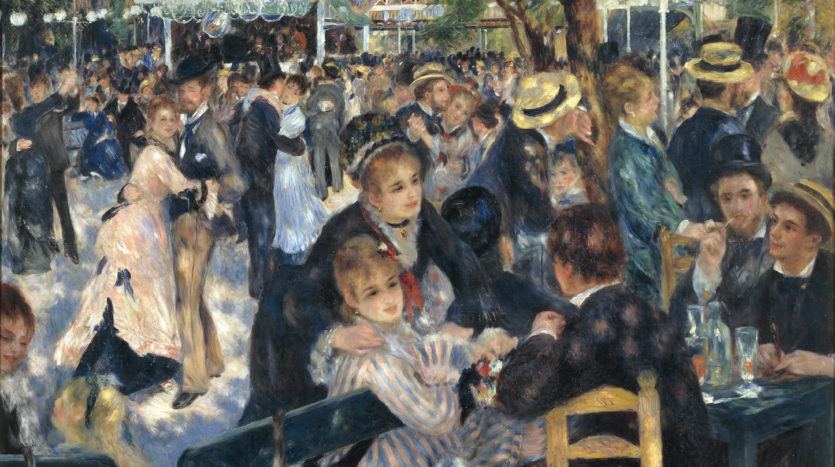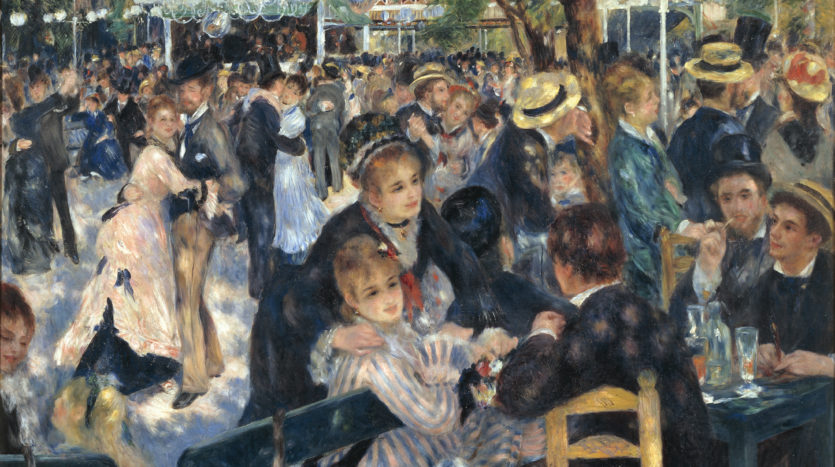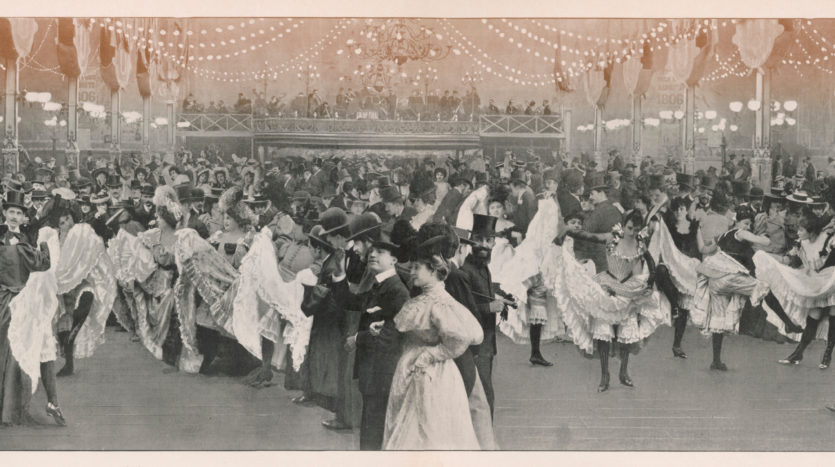Dance at the Moulin de la Galette Ball thanks to Renoir!
Any visitor to the Musée d’Orsay who suddenly feels the urge to bathe in the crowd need only immerse themselves in the contemplation of The Ball at the Moulin de la Galette. This work, painted by Auguste Renoir in 1876, also offers a soothing experience of a Sunday afternoon at the guinguette: a typical scene of the end of the 19th century in Montmartre. Zoom in on the formidable work of the illustrious painter, which is well suited to one of the most fabulous museums in Paris.
A painting, an ode to joy
If the Moulin de la Galette restaurant still exists, it has undoubtedly changed in appearance since Renoir used his talent to depict it in a respectable size of about 1.31m by 1.75m. The establishment – a large shed – owes its name to the rye breads once made there, called “galettes”, and the mill next door. The festive atmosphere was also due to the many Parisians who liked to chat or dance there on Sundays.
Beyond immortalising some of his friends present on the scene, the painter clearly aimed to retranscribe the joyful and good-natured atmosphere of this popular establishment, emblematic of the Montmartre life of his time and a participant in the beginning of the leisure era. There is a crowd and the effect of movement, of life bathed in both natural and artificial light, is treated with colourful and vibrant notes.
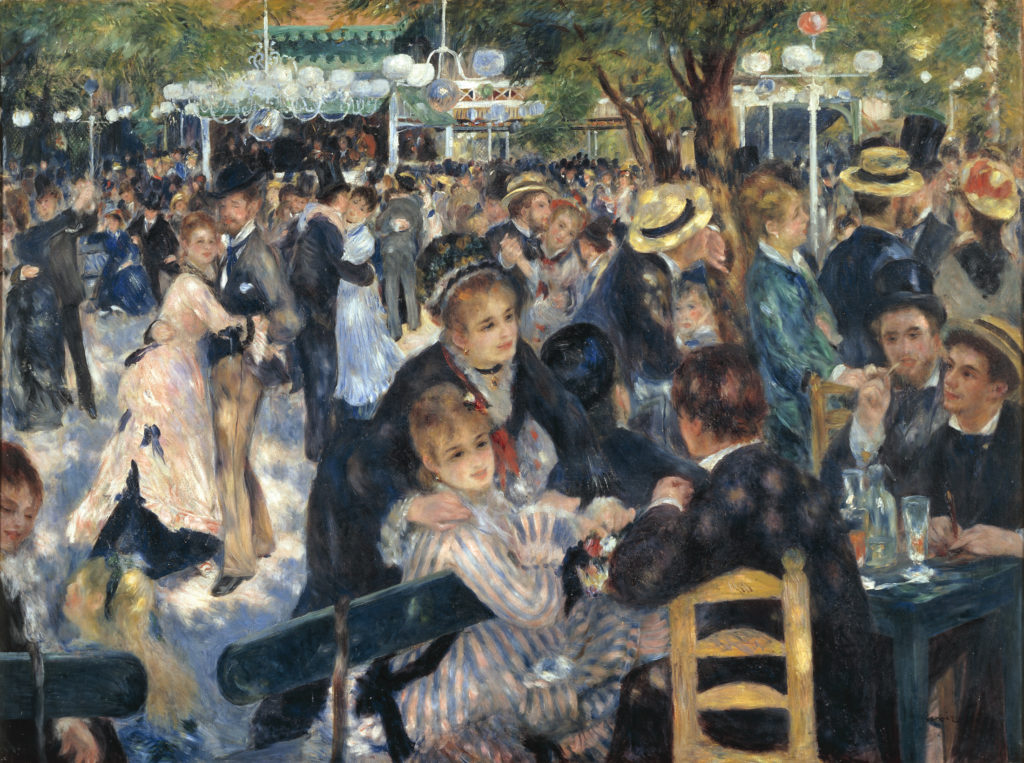
The work is solidly articulated around a diagonal separating the background from the foreground and the dancers from the drinkers, which is a feat in itself given the large number of characters represented. The disparate light, as if dancing and materialized by yellow, blue and pink spots, thus seems to cross the foliage of the trees and contributes to brighten up the scene as well as the smiles clearly visible on the faces. Instead of using blur to distinguish the depth of the painting, Renoir has endeavoured to gradually reduce the size of the figures and buildings, which may form a third plane.
Two particular details can be noted: the table in the foreground, composed of regulars of the place and friends of Renoir such as the painters Norbert Gœneutte and Franc-Lamy, and the couple of dancers on the left, who seem to interrupt their dance to look at the painter and therefore at the viewer.
Finally, it should be pointed out that the painting appears to be cut off, thanks to the missing body parts on the left and right. The painter’s message is clear: he has captured only a piece of reality and thus pays tribute to the greatness of the event represented.
Renoir, a famous but tortured artist
Born in 1841 in Limoges, Auguste Renoir lived to the respectable age of 78 before his death (in 1919) in Cagnes-sur-Mer. Although he suffered from the most common autoimmune disease in France, polyarthritis, the artist nevertheless did not lose out and presents a collection of varied works, totalling some 4,000 paintings!
And if in terms of painting, Renoir leaves us an impressive legacy of nudes, portraits, landscapes, seascapes, still lifes and genre scenes, the man was also a pastelist, engraver, lithographer, sculptor and draughtsman.

He was the sixth child of seven siblings and came from a working-class family, with a tailor father and a seamstress mother. At the age of 13, his family moved to Paris and Auguste Renoir began training as a decorator at the porcelain workshop Lévy Frères & Compagnie. He also attended evening classes at the École de Dessin et d’Arts Décoratifs for 18 years, before passing the entrance exam to the Ecole des Beaux-Arts de Paris in 1862 and joining Charles Gleyre’s studio, where he met Claude Monet, Frédéric Bazille and Alfred Sisley.
His career as a painter was marked by mixed beginnings, with works accepted at the Salon but not always praised by the critics – it should be noted, however, that his painting Lise à l’ombrelle, exhibited in 1868, was positively acclaimed by a young critic named Emile Zola. The said Lise, whose name was Tréhot, was a mistress who often served as a model for Renoir and who also gave him two children, Pierre and Jeanne, born in 1868 and 1870 respectively.
His career took a decisive turn during a stay with Monet at the Grenouillère, on the island of Croissy-sur-Seine, where he painted in the open air, learning to play with light and to banish black to represent shadows. This was the beginning of his Impressionist period, of which the Bal du Moulin de la Galette is perhaps the most accomplished work, following the guinguettes along the Seine presented by the artist in 1869 and showing his mastery of the techniques associated with this movement.
However, by 1880 Renoir’s paintings were no longer selling and he decided to leave the Impressionist world (and exhibitions) and exhibit again at the official Salon. He succeeded in making a name for himself and received a growing number of commissions, especially for portraits. He asserted his new style based on line effects, recognisable in famous works such as the Déjeuner des canotiers painted between 1880 and 1881. This scene shows Aline Charigot, who became Auguste Renoir’s wife in 1890 and gave him three more children.
The artist’s style would vary in the following decades, according to his travels and inspirations. In 1896 he acquired a house in Essoyes, which became the Renoir studio. The whole family met there regularly until the painter’s death in 1919. Health problems marked the last twenty years of his life, partly due to a bad fall on a bicycle in 1897 but also to illness. On the other hand, his art was doing well and, above all, selling well.
Before his death, he was able to visit the Louvre Museum one last time and contemplate some of his works from difficult periods. There is a Renoir museum in Cagnes-sur-Mer, where he lived his last years.
A word about the Musée d’Orsay
After having been in the private collection of Gustave Caillebotte until 1894, the Bal du Moulin de la Galette was exhibited at the Musée du Luxembourg and then at the Louvre, before being entrusted to the Musée d’Orsay in 1986 when it was inaugurated.
The transfer is logical, as the Musée d’Orsay has the largest Impressionist and Post-Impressionist collection in the world, with nearly 1,100 paintings, alongside some 3,600 other works. The collection includes such evocative works as Manet’s Déjeuner sur l’herbe, Cézanne’s Les joueurs de cartes and Degas’ La Petite Danseuse de quatorze ans.
The Musée d’Orsay extends its collections well beyond painting, and you can admire a plethora of decorative arts objects from the period 1848-1914, presented out of context except for the Charpentier dining room from 1900. The collection bears witness to the impact of the industrial revolution on the production of objects, particularly decorative ones.
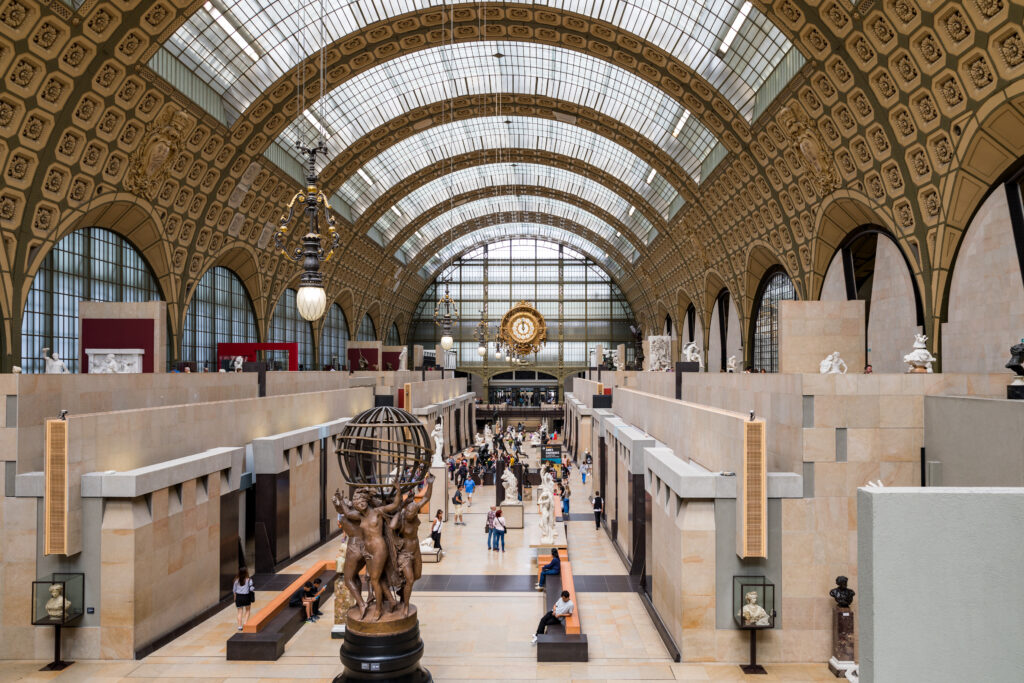
Sculpture is not forgotten, with 1,598 works on display within the structure. This richness is explained in particular by the fact that the 19th century saw an explosion in the production of sculptures at the request of the bourgeoisie wishing to decorate their homes and of politicians wishing to anchor their beliefs. The world only turned away from this art form after 1945, when there was a clear lack of interest, with the exception of a few recognised artists such as Rodin. The Musée d’Orsay, with its purpose-built exhibition space, brings to light many works that have long been kept in the reserves of the Louvre, the Musée du Luxembourg or the State.
Let’s not forget the more than 45,000 photographs also on display in this exceptional museum, offering a special place to the achievements of talents such as Édouard Baldus, Christian Bérard, Louis-Jacques-Mandé Daguerre and Céline Laguarde.
A visit to the Musée d’Orsay can therefore be motivated by many desires, thanks to the diversity of the works on display. The Moulin de la Galette Ball is nevertheless a masterpiece and a reason to go there. For the record, when the work was presented at the third Impressionist exhibition in 1877, the art critic Georges Rivière, who was himself represented on the stage of the Bal du Moulin de la Galette, hailed his friend’s work as “a page of history, a precious monument to Parisian life, of rigorous accuracy”. Find it quickly on the upper level of the Musée d’Orsay, in room 32!


